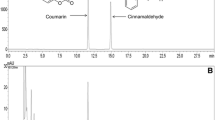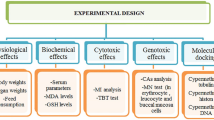Abstract
In our experiments we first tested the ability of different concentrations of trypaflavine and hexamethylenetetramine to induce dominant lethal mutations by injecting the compounds intraperitoneally or orally into male mice. Only for high dosages the induction of dominant lethals could be ascertained (50 mg trypaflavine per kg body weight and 25000 mg/kg hexamethylenetetramine). No specific sensitivity of single stages of the cycle of spermatogenesis was observed. It could be demonstrated by fluorescence microscopy that trypaflavine invades the male germ cells. Further indications for the weak mutagenicity of this compound we received cytogenetically by finding some chromosome aberrations and increased rates of univalents in diakinesis.
In vitro investigations with hexamethylenetetramine in high final concentrations used in the mice experiments induced cell death, depression of mitosis and clumping of chromosomal material in blood cells as well as in HeLa cell cultures. Lower concentrations tested on HeLa cells were found to induce a number of chromosomal aberrations, but in a certain dosage, only (1×10-3M). No chromosome changes could be recognized in blood or HeLa cell mitosis when hexamethylenetetramine was given in final concentrations 1×10-4M and lower.
A comparison of the used concentrations of the test substances and their mutagenic efficiency with the usual therapeutic dosages give rise to assume that the genetic risk for man is low for both drugs.
Similar content being viewed by others
Literatur
Alderson, Th.: The mechanism of formaldehyde-induced mutagenesis. The monohydroxymethylation reaction of formaldehyde with adenylic acid as the necessary and sufficient condition for the mediation of the mutagenic activity of formaldehyde. Mutat. Res. 1, 77–85 (1964).
d'Amato, F.: itStudio dell attività mutagena dell' acridina e derivati. Caryologia 2, 229–297 (1950).
Arkel, G. A. van: Modification of ultraviolet and formaldehyde mutagenesis in Aspergillus nidulans. Dissertation an der Universität Utrecht 1958.
Auerbach, C.: Analysis of the mutagenic action of formaldehyde food. III. Conditions influencing the effectiveness of treatment. Z. indukt. Abstamm.-u. Vererb.-Lehre 87, 627–647 (1956).
— and H. Moser: An analysis of the mutagenic action of formaldehyde food. I. Sensitivity of Drosophila germ cells. Z. indukt. Abstamm.- u. Vererb.-Lehre 85, 479–504 (1953a).
—: An analysis of the mutagenic action of formaldehyde food. II. The mutagenic potentialities of the treatment. Z. indukt. Abstamm.- u. Vererb.-Lehre 85, 547–563 (1953b).
Baldermann, K. H.: Untersuchungen über eine mögliche mutagene Wirkung von Trypaflavin bei der Maus. Inaugural-Dissertation, Heidelberg 1967.
Bateman, A. J.: Mutagenic sensitivity of maturing germ cells in the male mouse. Heredity 12, 213–232 (1958).
Beers Jr., R. F., D. D. Hendley, and R. F. Steiner: Inhibition and activation of polynucleotide phosphorylase through the formation of complexes between acridineorange and polynucleotides. Nature (Lond.) 182, 242–255 (1958).
— and G. Armiles: Heterogenous binding of acridine orange by polyribonucleotides. Nature (Lond.) 208, 466–468 (1965).
Bishop, M. W., and J. Smiles: Induced fluorescence in mammalian gametes with acridineorange. Nature (Lond.) 179, 307–308 (1957).
Boyle, R. E., S. S. Nelson, F. R. Dollish, and J. M. Olsen: The interaction of deoxyribonucleic acid and acridine orange. Arch. Biochem. 96, 47–50 (1962).
Brittinger, D.: Die mutagene Wirkung von Endoxan bei der Maus. Humangenetik 3, 156–165 (1966).
Bradley, D. F., and G. Felsenfeld: Aggregation of an acridine dye on native and denatured deoxyribonucleates. Nature (Lond.) 184, 1920–1922 (1965).
— and M. K. Wolf: Aggregation of dyes bound to polyanions. Proc. nat. Acad. Sci. (Wash.) 45, 944–952 (1959).
Brenner, S., L. Barnett, F. H. C. Crick, and A. Orgel: The theory of mutagenesis. J. molec. Biol. 3, 121–124 (1961).
Crick, F. H. C., L. Barnett, S. Brenner, and R. J. Watts-Tobin: General nature of the genetic code for proteins. Nature (Lond.) 192, 1227–1232 (1961).
Demerec, M.: Chemical mutagens. Proc. 8th Intern. Congr. Genetics (Hereditas Suppl.) 201–209 (1949).
— G. Bertani, and J. Flont: A survey of chemicals for mutagenic action on E. coli. Amer. Nat. 85, 119–136 (1951).
Drake, J. W.: Properties of ultraviolet induced r II mutants of bacteriophage T4. J. molec. Biol. 6, 268–283 (1963).
— Studies on the induction of mutations in bacteriophage T4 by UV irradiation and by Proflavin. J. cell. comp. Physiol. 64, Supl. 1, 19–32 (1964).
Dulbecco, R., and M. Vogt: Studies on the induction of mutations in poliovirus by Proflavin. Virology 5, 220–235 (1958).
Edwards, R. G.: The experimental induction of gynogenesis in the mouse. III. Treatment of sperm with trypaflavine, toluidine blue or nitrogen mustard. Proc. roy. Soc. B 149, 117–129 (1958).
Herskowitz, I. H.: The differential induction of lethal mutations by formalin in the two sexes of Drosophila. Science (Lancaster) 112, 302–303 (1950).
— Mutation rate in Drosophila melanogaster males treated with formaldehyde and 2,4-dinitrophenol. Genetics 36, 554–555 (1951).
Hirota, Y.: The effect of acridine dyes on mating type factors in Escherichia coli. Proc. nat. Acad. Sci. (Wash.) 46, 57–64 (1960).
Kihlman, B.: Cytological effects of phenylnitrosamines. I. The production of structural chromosome changes in the presence of light and acridine orange. Rad. Bot. 1, 35–42 (1961).
Khishin, A. F.: Induction of mutations by formaldehyde solutions in Drosophila melanogaster. Amer. Nat. 90, 377–380 (1956).
—: Formaldehyde solutions applied by submersion. Dros. Inf. Serv. 33, 141–142 (1959).
Leblond, C. P., and Y. Clermont: Spermiogenesis of rat, mouse, hamster and Guinea pig as revealed by the “periodic-acid-Fuchsin sulfurous acid” technique. Amer. J. Anat. 90, 167–215 (1952).
Lerman, L. S.: Structural considerations in the interaction of DNA and acridines. J. molec. Biol. 3, 18–30 (1961).
—: The structure of the DNA-acridine-complex. Proc. nat. Acad. Sci. (Wash.) 49, 94–102 (1963).
—: Amino group reactivity in DNA-acridine-complexes. J. molec. Biol. 10, 1407–1414 (1964a).
—: Acridine mutagens and DNA-structure. J. cell. comp. Physiol. 64, Supl. 1, 1–18 (1964b).
Loveless, A.: Qualitative aspects of the chemistry and biology of radiomimetic (mutagenic) substances. Nature (Lond.) 167, 338–342 (1951).
Lüers, H., u. G. Röhrborn: Chemische Konstitution und mutagene Wirkung. III. Äthylenimine. Mutat. Res. 2, 29–44 (1965).
Luzzati, V., F. Masson, and L. S. Lerman: Interaction of DNA and Proflavine: A smallangle X-ray scattering study. J. molec. Biol. 3, 634–639 (1961).
de Mars, R. I.: Chemical mutagenesis on bacteriophage T2. Nature (Lond.) 172, 964 (1953).
Michaelis, A., u. R. Rieger: Über den Einfluß von Acridinfarbstoffen auf die Induktion von Chromatidenaberrationen durch Radiomimetica. Die Kulturpflanze 11, 403–415 (1963).
Moorhead, P. S., P. C. Nowell, W. J. Mellman, D. M. Battips, and D. A. Hungerford: Chromosome preparation of leukocytes cultured from human peripheral blood. Exp. Cell Res. 20, 613 (1960)
Nuti-Ronchi, V.: Nuovo dati sull' attività mutagena dell' arancio di acridina in Allium cepa. Cariologia 14, 193–203 (1961).
— and F. d'Amato: New data on chromosome breakage by acridine orange in the Allium test. Caryologia 14, 163–165 (1961).
Ostertag, W., and W. Kersten: The action of Proflavine and Actinomycin D in causing chromatid breakage in human cells. Exp. Cell Res. 39, 296–301 (1965).
Peacocke, A. R., and J. N. H. Skerret: The interaction of aminoacridines with nucleic acids. Trans Faraday Soc. 52, 261–279 (1956).
Rapoport, I. A.: Carbonylverbindungen und der chemische Mutationsmechanismus. C. R. Acad. Sci. USSR 54, 65–67 (1946).
Rieger, R., u. A. Michaelis: Die Auslösung von Chromosomenaberrationen bei Vicia faba durch chemische Agenzien. — Eine Übersicht. Die Kulturpflanze 10, 212–292 (1962).
Röhrborn, G.: Über mögliche mutagene Nebenwirkungen von Arzneimitteln beim Menschen. Humangenetik 1, 205–231 (1965a).
Röhrborn, G.: Über die mutagene Wirksamkeit von Pharmaka unter besonderer Berücksichtigung von Cloräthylenaminderivaten. Habilitationsschrift, Heidelberg 1965 b.
—: Die mutagene Wirkung von Trenimon bei der männlichen Maus. Humangenetik 1, 576–578 (1965c).
Schleiermacher, E.: Über den Einfluß von Trenimon und Endoxan auf die Meiose der männlichen Maus. I. Methodik der Präparation und Analyse meiotischer Teilungen. Humangenetik 3, 127–133 (1966a).
—: Über den Einfluß von Trenimon und Endoxan auf die Meiose der männlichen Maus. II. Cytogenetische Befunde nach Behandlung mit Trenimon und Endoxan. Humangenetik 3, 134–155 (1966b).
Scholtissek, E., and R. Rott: Binding of Proflavine to deoxyribonucleic acid and ribonucleic acid and its biological significance. Nature (Lond.) 204, 39–43 (1964).
Snell, J.: Biology of the laboratory mouse. New York: Dover Publications 1941.
Szybalski, W.: Special microbiological systems. II. Observations on chemical mutagenesis in microorganisms. Ann. N. Y. Acad. Sci. 76, 475–489 (1958).
Terzaghi, E., Y. Okada, G. Streisinger, J. Emrich, M. Inouye, and A. Tsugita: Change of a sequence of amino acids in phage T4 lysozyme by acridine-induced mutations. Proc. nat. Acad. Sci. (Wash.) 56, 500–507 (1966).
Westergaard, M.: Chemical mutagenesis in relation to the concept of the gene. Experientia (Basel) 13, 224–234 (1957).
Witkin, E. M.: Mutations in Escherichia coli induced by chemical agents. Cold Spr. Harb. Symp. quant. Biol. 12, 256–269 (1947).
Author information
Authors and Affiliations
Rights and permissions
About this article
Cite this article
Baldermann, K.H., Röhrborn, G. & Schroeder, T.M. Mutagenitätsuntersuchungen mit Trypaflavin und Hexamethylentetramin am Säuger in vivo und in vitro. Hum Genet 4, 112–126 (1967). https://doi.org/10.1007/BF00291255
Received:
Issue Date:
DOI: https://doi.org/10.1007/BF00291255




